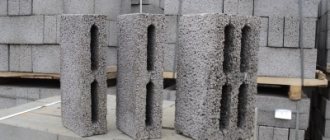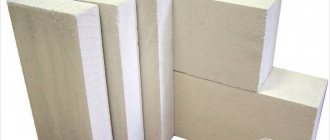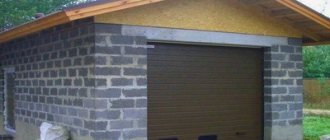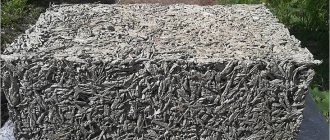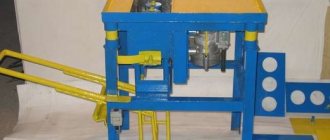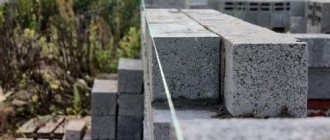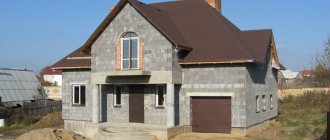In the ranking of inexpensive ways to arrange steam rooms with your own hands, a bathhouse made of expanded clay concrete blocks rightly occupies one of the first places. The reason for such high popularity is the availability of technology for manufacturing materials for masonry walls. Only by making expanded clay concrete with your own hands can you save more than one thousand on a bathhouse made of expanded clay blocks, while remaining completely confident in the quality and reliability of the material.
Bathhouse made of expanded clay blocks
The use of expanded clay concrete for the construction of a bathhouse is not something exceptional. The technology of super-light concrete based on expanded clay pellets and a plastic cement-sand matrix has been used in construction for more than half a century. Therefore, it is not surprising that the idea of building a bathhouse from expanded clay concrete blocks with your own hands arose. True, screeding or insulating a floor with expanded clay with concrete pouring is somewhat different from a full-fledged block used in the construction of a bathhouse.
What you need to know about sauna blocks:
- Expanded clay concrete stone is a cast rectangular block measuring 39x19x18.5 cm, with or without internal cavities. Accordingly, the weight of the stone ranges from 10–18 kg, depending on the number of voids. On this basis, blocks are divided into wall and partition;
- The most important characteristics for bathhouse walls - thermal conductivity and frost resistance are 0.24-0.57 W/m2*C and F25-F100, respectively. This is about the level of a good red brick.
Important!
Unlike all existing wall blocks, with the possible exception of wood concrete, expanded clay concrete has a specific cellular structure, so the process of shrinkage of “fresh” bathhouse walls proceeds unnoticed, with minimal changes, which is practically not taken into account for one-story buildings. The material absorbs water vapor, this indicator is an order of magnitude less than that of foam blocks and aerated concrete, so some bathhouse owners do not even spend money on protective external wall decoration. In this case, the insulation of a bathhouse made of expanded clay concrete blocks is carried out from the inside of the room.
Is it possible to build a bathhouse from expanded clay concrete blocks?
The technology for making expanded clay blocks, simple and accessible for home-made use, also has a downside. The quality and safety of expanded clay concrete stone depend on the characteristics of the filler. According to the requirements of GOST 6133-99, expanded clay 10-12 mm from clay with a high content of fluorspar should be used. Due to fluorine compounds, expanded clay granules are obtained with a smooth and durable surface.
Despite the high toxicity of fluorine, its salts are in a vitrified state, so they do not pose any danger, especially under a layer of concrete. If the raw materials have passed radiation and environmental control, then any residential premises can be built from such expanded clay concrete blocks.
Sometimes in semi-handicraft production, burnt quarry yellow clay is used instead of scarce expanded clay. After drying and firing, small pieces are obtained, light and porous, like pumice. Since the glass transition of the granules did not occur during the drying process, the heavy metal impurities contained can easily get into the water or onto the walls of the bathhouse. Often manufacturers simply sin by adding blast furnace or furnace slag, whose background radiation is always 60-80% higher than natural.
Advice! If you are not completely confident in the safety of expanded clay concrete blocks purchased cheaply for a bathhouse, then it would be useful to check the surface with a quarry dosimeter.
Well, according to the rules, such material must be tested for the content of lead, chromium, antimony and mercury salts.
Bathhouse made of expanded clay concrete blocks: pros and cons
If we consider the material only as a means for constructing the walls of a bathhouse, then it can be noted that expanded clay concrete is much better than cinder block, foam and aerated concrete.
It is clear that a bathhouse made of expanded clay blocks has its pros and cons. There are much more of the former than the latter.
The obvious advantages of building a bathhouse from expanded clay concrete include four points:
- Low cost of expanded clay concrete blocks. The price of one standard stone ranges from 0.3-1.0 dollars per piece;
- Expanded clay concrete is easy to transport and lay. On average, it will take a maximum of a week of time to assemble a bathhouse box made of expanded clay concrete blocks according to a design of 5x4 m or 6x4 m;
- Excellent fire resistance. The bathhouse box, even when completely engulfed in flames, can stand without destruction or deformation for almost three hours.
To build a bathhouse, the manufacture of a rigid foundation such as MZLF or a monolithic slab is not required.
The only disadvantage that can be noted is the tendency of expanded clay to absorb water. And although most of the moisture is drawn out of the filler by the cement grain, local “wet” areas may remain, through which frost can easily penetrate the walls of the bathhouse.
Advice! You can indirectly confirm the quality of the material using a square and a ruler.
For a commercial block, the dimensions are always the same; for a semi-handicraft stone, the geometry is not all right. Therefore, there is reason to doubt its quality.
Peculiarities
Bathhouses are not uncommon these days. It is built from different materials. Most often, of course, there are structures made of wood. However, such buildings must be carefully looked after so that they retain their original appearance and do not rot over time. In addition, wooden baths are fire hazardous, even if they are treated with special impregnations.
Their use in the construction of baths is not rare. Many owners choose just such materials, as they have many positive characteristics and are superior to wood in many respects.
The main feature of building blocks is their porous structure. In this case, the pore sizes (as well as their shape) can vary chaotically over the entire area of the block. Due to this distinctive characteristic, the mechanical and thermophysical properties of such building materials are not uniform. Because of this, the bathhouse must be very carefully insulated not only from the inside, but also from the outside.
It is worth noting that the blocks absorb moisture like a sponge. In the summer season, this feature does not mean anything terrible, but in winter, previously absorbed water will freeze and increase in volume. This can lead to sad consequences - the destruction of blocks. Of course, this problem can be completely avoided. To do this, it is necessary to provide the building with high-quality waterproofing inside and outside.
Bathhouse projects made of expanded clay concrete blocks
The standard layout and design of a sauna building made of expanded clay concrete is not very different from traditional buildings made of cinder block or foam concrete. The most popular solution is the design of a bathhouse with a 6x4 attic made of expanded clay concrete.
The standard layout of such a bath looks like this:
- On the ground floor there is a relaxation room and a steam room with a washing area;
- There is a guest room in the attic;
- The bathroom or boiler equipment is removed outside the building.
The bathhouse box can be modest, gray, without external decoration, as in the photo.
But more often, owners prefer to hide the nondescript frame of the bathhouse under a beautiful lining made of plastic and natural wood.
A sauna building made of expanded clay concrete will look more natural if the façade and gables are covered with clapboard polished to look like a log, and the walls are lined with white siding.
What is expanded clay concrete?
Expanded clay concrete is a type of building material. It is monolithic and hardens naturally. It consists of expanded clay, cement, sand, as well as special air-entraining additives. It differs from traditional concrete by its lightweight filler – expanded clay.
Expanded clay concrete block Source beton-house.com
Do-it-yourself bathhouse made of expanded clay concrete blocks
Before you start building the box, you will need to stock up on materials and lay communications. Before the first stone is laid at the base of the bathhouse foundation, it will be necessary to lay sewer pipes or install a septic tank. Water is brought into the bathhouse after the walls have been erected and the ceiling has been laid.
Despite the fact that expanded clay concrete blocks are quite light and do not require special equipment, without water and electricity it will be very difficult to build a bathhouse from expanded clay.
Preparation
Expanded clay concrete blocks are delivered to the site and unloaded on pallets at a distance of no more than 10 m from the foundation. Before starting work, the material is covered with film to prevent the stones from getting stuck. The unloaded blocks are inspected and rejected, those on which expanded clay appears on more than half of the side surface area are removed.
Under the foundation of the bathhouse, they remove the top layer of turf, cut a trench under the foundation strip and fill the inner area with a sand-gravel mixture, as is done when laying paving slabs.
Construction of the foundation
The easiest way to lay a foundation strip involves using discarded expanded clay concrete blocks. As an option, you can even buy an additional batch of discarded expanded clay concrete with slight deviations in geometry for arranging the foundation of the bathhouse. The material has excellent thermal insulation, so it is much better suited for tape than cast concrete or FBS blocks.
The only condition is to ensure good waterproofing of the walls and the base of the foundation. The blocks can be coated with mastic paired with a dense polypropylene film. If the bathhouse box is less than 3x3 m, then the blocks do not even need to be filled with concrete; the joints and cracks are simply covered with a dry mixture of cement and sand. For full-size bathhouse buildings, the tape is filled with concrete, and if there is at least a slight surface slope on the site, then the tape under the expanded clay concrete masonry will need to be reinforced with reinforcing mesh.
If the climate in a given area is quite harsh, with severe frosts in winter, then before laying the blocks it is necessary to insulate the subfloor of the bathhouse, and after assembly, insulate the outer surface of the foundation walls.
What to put the blocks on
The outer surface of the laid tape must be rolled up with roofing felt, the material is tucked, and the edges are attached to the vertical surfaces of the base. The first row of masonry is carried out using a regular cement-sand mortar 1:3 with the obligatory addition of a plasticizer that reduces shrinkage of the joints.
On average, the thickness of the seam should not be more than 3 mm. Despite their good thermal insulation properties, expanded clay concrete blocks laid in the basement row may suffer from excess moisture on the foundation area. Therefore, it is best to lay out the first two or three rows of the plinth from solid red brick.
Wall installation
To build the box, it is best to use hollow expanded clay concrete stones; they are lighter and easier to work with; most of the masonry work can be done independently.
In addition, it is possible to reduce the thickness of the insulation of a bathhouse made of expanded clay concrete blocks.
Every four rows of walls, as well as the upper part of the masonry, corners and joints with internal walls must be reinforced with steel corners, mesh and rod reinforcement. The material is placed in grooved grooves and glued with a masonry mixture with the addition of an acrylic primer.
Exterior cladding
The outer surface of the walls does not require special means of protection, but the cladding must be porous enough to allow water vapor to pass through, and at the same time dense to retain water in a liquid state.
For finishing work, two types of cladding are used - a ventilated version in the form of siding or lining and ordinary cement-sand plaster. The release of water vapor on the outer walls of the bathhouse is considered small, so you can even use decorative plaster.
For expanded clay concrete baths, this type of finishing is rarely used due to the high cost of the material. And the surface of the expanded clay concrete block itself is quite rough, so you have to plaster it with cement mortar, and only then apply a decorative coating.
Interior decoration of a bathhouse made of expanded clay concrete blocks
For different rooms, different approaches are used in the design of walls and ceilings. For the steam room, continuous lining of the walls with linden or aspen lining is traditionally used. It is clear that under the cladding it is necessary to lay insulation made of mineral wool, a film with glued aluminum foil.
The dressing room and washing compartment of the bathhouse are finished in approximately the same style. Regardless of whether it is a decorative strip or panels, a ventilation gap must be left between the cladding and the wall made of expanded clay concrete blocks.
Sometimes customers lay ceramic tiles directly on the insulation. This method works if polystyrene foam or EPS is used, which do not allow water vapor to pass through. In other cases, the decorative coating will become damp.
Floor insulation
Experts recommend choosing expanded clay as floor insulation for a steam room - an environmentally friendly and warm option. Thermal insulation of the floor is carried out in the following sequence:
- a rough concrete screed is made;
- as soon as the concrete sets, a waterproofing layer is laid;
- the selected type of heat insulator is laid on the waterproofing;
- a finishing screed with reinforcing mesh is placed on top of the heat insulator;
- After the concrete has completely set, the floor is covered with the selected finishing coating.
As you can understand, the process of insulating a steam room is quite simple and understandable. The most important thing is to believe in your own strengths, not to lose patience and make every effort. And there is no doubt that with this approach to business, success will be guaranteed to every home craftsman. If you have any questions about insulation, you can safely go to the Internet resource at a time convenient for you and watch a training video conducted by real masters of their craft.
https://youtube.com/watch?v=t-Nzx6yvsrg
How to insulate a bathhouse made of expanded clay concrete blocks from the inside
The specific structure of expanded clay concrete confuses even experienced bath attendants. The secret to properly insulating a bathhouse from expanded clay concrete blocks from the inside can be understood from the video here:
First of all, you need to understand that expanded clay has high permeability to air, which means that any air flow blowing across the walls of the bathhouse will easily cause heat to evaporate through the porous expanded clay concrete surface. Due to convection, the heat loss of a bathhouse may be higher than that of gas silicate, since the pores in expanded clay are two orders of magnitude larger than those of foamed silicate.
Lining expanded clay concrete on the outer surface is not a good idea; in this way you can trap water vapor inside the wall. There is only one thing left - to insulate the expanded clay concrete bathhouse from the inside.
The steam room is insulated with mineral wool laid on two layers of vapor barrier membrane. A foil film must be laid over the insulation and a ventilation gap must be made.
For the remaining rooms of the bathhouse, a completely different approach is used. The rest room and dressing room are insulated as shown in the diagram.
For warm but not hot bath rooms, walls made of expanded clay concrete blocks are covered with ordinary high-density foam plastic, at least 50 mm thick for normal climates, and 100 mm for northern latitudes. A reinforcing painting mesh is laid on top of the polystyrene foam, after which decorative plaster, tiles or any other type of decor can be applied.
This scheme blocks the penetration of warm air through the pores and seams of expanded clay concrete. This solution requires additional supply and exhaust ventilation equipment for the bathhouse, but it manages to save 90% of the heat.
Often, before laying thermal insulation, the joints between expanded clay concrete blocks have to be blown in with foam.
Few disadvantages
Of course, it is fair to say that this product is not perfect and has some shortcomings. However, given the number of advantages, the negative features have virtually no effect on the opinion of users. We are talking about the following:
- When building structures from this product, you will have to spend some time leveling the masonry, that is, apply 3 centimeters of cement on top of the material;
- You will still have to carry out additional thermal insulation work;
- No matter how good the blocks are, it is still not recommended to erect high-rise buildings using them.
In addition, before you start purchasing the material directly, it is worth studying the descriptions offered by the manufacturers. From them you can easily understand that this product is somewhat more fragile than its counterpart - traditional concrete. In this regard, you may need more extensive preparatory work before construction, which includes detailed instructions to workers.
Approximate layout of the bathhouse
Plan diagram of the simplest structure, area 12m2
Scheme of a bathhouse with an entrance hall and a terrace
Bathhouse made of expanded clay concrete blocks: reviews
Vasily Andreevich Bezhsky, 44 years old, Ryazan:
I can say right away that it is very difficult to find high-quality expanded clay concrete on the market. It got to the point that one company was making blocks on a machine in my presence. And even after this, approximately 10% of the expanded clay concrete stone had to be rejected. But in terms of characteristics, you cannot find a better material for a bath; it turns out much cheaper than timber or even foam concrete. I insulated the walls on the outer and inner surfaces with the same roofing mats made of basalt fiber. The stove stands right next to the expanded clay concrete wall, and there are no problems. You can only insulate the floor and ceiling with polystyrene foam; it’s more reliable and the logs and beams rot less.
Artem Alekseevich, 37 years old, Chelyabinsk:
For all their advantages, expanded clay concrete blocks are a weak material, so when the idea arose to build one box for a bathhouse and a summer kitchen, we had to spend heavily on metal ties and fittings. Once they dropped a beam from the second floor onto the wall and split two expanded clay concrete blocks. I had to cut and replace the stone. If you install a residential attic or attic, you will need to additionally cast supports or install steel posts on the reinforcement frame along the contour. This is the only way to keep expanded clay concrete walls from spreading with a very high and large roof.
Preparation for construction
In order for the design to be reliable, it is necessary to take ready-made projects. They indicate in detail the dimensions of the future bathhouse and the necessary materials. It is recommended to think about renting construction equipment, as it will make the work go faster.
The tools we will need are:
- Building level or alternative electronic tool;
- Spatulas - it is recommended to take tools of different sizes;
- Pegs for marking;
- Rope;
- Rollers, including rubber ones, for leveling the surface.
- Tools for digging a trench - these can be replaced by rented construction equipment.
Blocks must be purchased from a trusted place; when choosing, check whether there are any chips or cracks on the blocks. To build a bathhouse, you don’t need many of them, so you can spend time checking the blocks.
Furnace structure
You cannot ignore such a moment as choosing a stove bath. The main criterion for this choice is the achieved thermal power and the ability to adjust it. The size of the steam room helps determine whether sufficient heat is generated. On summer days it will warm up in an average of 30 minutes, and in winter about an hour.
Taking into account the heating of the oven, the stones in it and the water tank, the resulting figure can be safely increased by 2.5–3 times
The adjustment methods are as follows:
- air control;
- heat removal to the outside;
- adjusting the flow of fuel inside.
You cannot install a low-power device that would reduce costs. After all, even if such a furnace manages to work properly, it will have to produce all possible power and continuously work to the point of wear and tear. Therefore, the service life is noticeably reduced. A traditional-looking stone stove will only be acceptable if you have a professional stove maker in mind. Adherence to tradition will force you to put up with prolonged heating and difficulties during ignition.
The firebox can be either elongated for installation in a wall, or regular. The first type has lower fire risks and allows you to create a comfortable microclimate, but may be more expensive. To reproduce a real Russian stove, it is recommended to buy an autonomous electric steam generator; it can cope with all possible problems.
In the open format, the air is heated by the stones themselves, heated on the fire. This solution is ideal for a heavily visited bathhouse: the air in the steam room is thoroughly warmed up very quickly and cooled down in the same way. The closed oven is equipped with a special damper that helps isolate the top row of stones. But long-term retention of heat results in slower heating overall. Among other parameters, it is always worth finding out how long the stove can heat a room without receiving additional fuel.
How to insulate: suitable materials
Construction experts believe that expanded clay concrete is best combined with mineral wool and expanded polystyrene slabs. That is why they recommend using these materials as insulation for bath walls.
First of all, both of these materials have good vapor barrier and air exchange, and these qualities are used as an important element of characteristics that actively prevents the formation of condensation inside the walls of premises, which makes the formation of fungi and mold impossible. The lower the vapor barrier numbers, the better for the overall thermal conductivity of the walls.
Mineral wool and expanded polystyrene help create a favorable microclimate and comfortable temperature in the room even at the stage of installation work. Especially, these insulation materials are recommended for regions with harsh climatic conditions.
Mineral wool:
Polystyrene foam insulation:
The advantages of materials include saving money spent on heating (stove, steam), when you do not need to spend additional money on using electric convectors.
Mineral wool and expanded polystyrene are found in slabs and rolls. Each master independently chooses what exactly is convenient for him to work with. Any of the presented materials is affordable, and is often installed inside plasterboard structures, taking into account the installation of additional vapor barrier.
The compositions of materials differ in hardness and characteristic features for improving the composition, which are indicated by manufacturers on product labeling. The peculiarity of expanded polystyrene is its division into ordinary and extruded.
Both varieties do not absorb moisture, are not afraid of mechanical stress, have good adhesion, elasticity, dimensional stability and low weight, are easy to process and fasten using polyurethane glue, foam, and fasteners installed on the frames.
